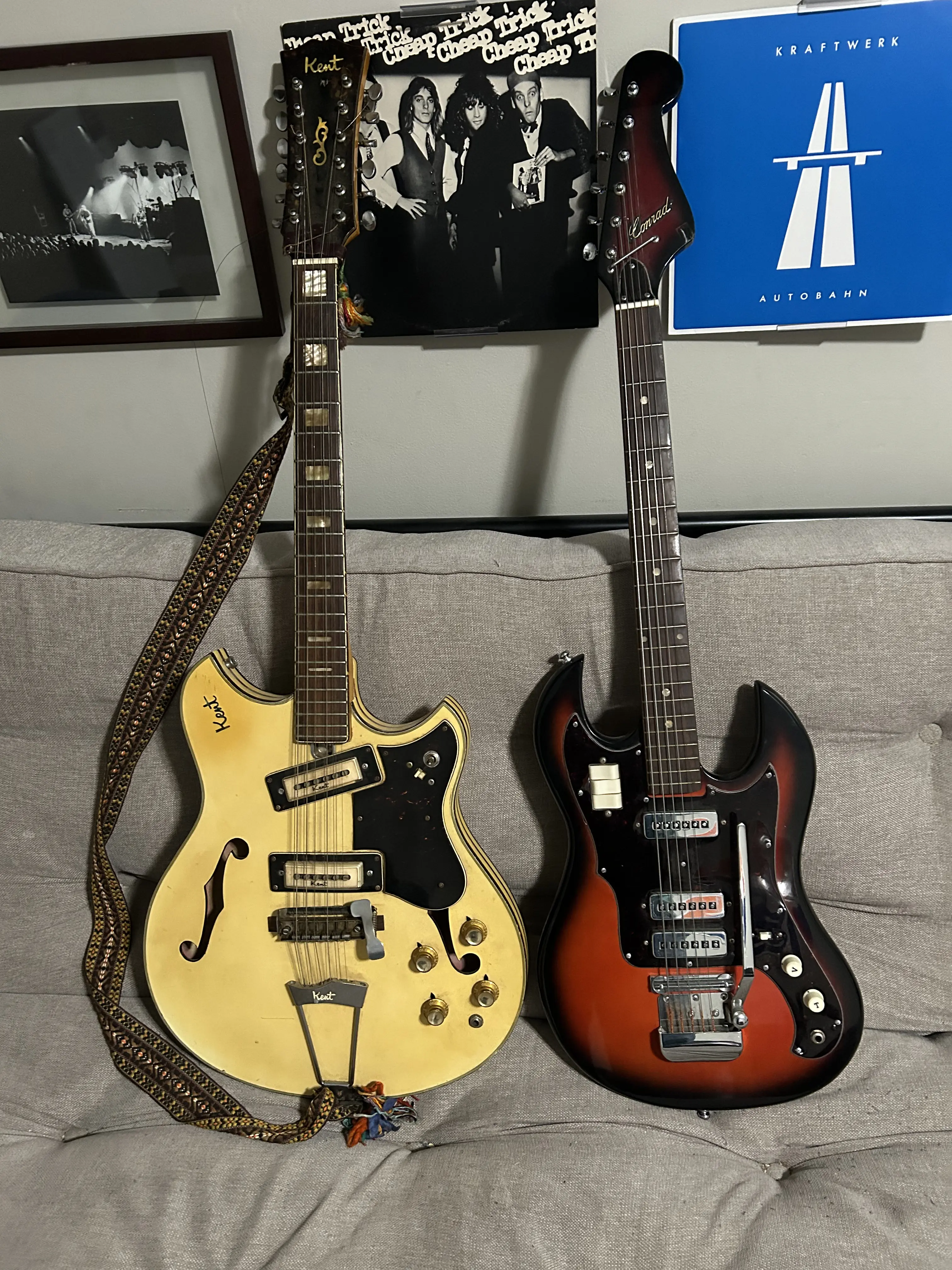I wandered into a couple of guitars at an estate sale. Really, my weakness: mid 1960s Japanese guitars sold under local brand names.
As is typical, they wanted market value as if they were ready to play. They needed a great deal of restoration, and obviously I have to make sure that I can cover fees, shipping, etc.
Luckily I brought a headphone amp and they did have some strings, so I could tell them that only 1 pickup between the 2 guitars worked.
I gave them a price for both, left, and they called be back.
So yay! I got a couple mid-60s Japanese oddball gems.

Kent 12 string
The one on the left is in rougher shape. It’s a Kent hollowbody 12 string. It was definitely well used.
I need to do more research on it, but I’ve been spending my time getting it working. I had to pull the strings to really do anything, but I think I got all of the electronics back in shape with some cleaning.
The rosewood on the fretboard and saddle was vert dry, but some tung oil brought it right back to life.
On the topic of the saddle, the original holes are plugged and it was shifted back about 3/4". I’m curious if that was because of a problem or to fix intonation. I don’t see damage around the original holes that indicate the former.
I was able to reinforce the small cracks with CA glue but not hide them. I left the dents and dings as-is. I don’t like undoing the character of the guitar.
The tuners needed to be disassembled, lubricated, and tightened, but are in good shape.
The bad parts are the frets and nut. The frets are worn past recoverable. I don’t replace frets because that’s like buying someone shoes. If they need new, I’d like the owner to decide what type. I’d normally carve a new bone nut, but without the frets in place, it’s pretty silly. This one “works” it’s just kinda crap.
It’s a super cool guitar, though. Even with the rusty strings, the hollow body really rings out. In quick looking, I haven’t found another one in anything but a burst. I think the color is pretty cool. I like that it was really used so much.
Much like it was originally, it’ll be a great guitar for a bargain. I’m not interested in owning a 12 string, so it’ll definitely go up for sale.
Conrad Bison
The guitar on the right is even more fascinating to me. It’s that classic mid-60s Japanese layout. 3 pickups with toggles for each… I love toggles.
It was manufactured by Matsumoku and is just so well built. My only issue is that there is the little rectangle in the back of the neck as a shim.
The body is beautiful mahogany and the routing is better than a modern MIM Fender. Even the wiring in it is beautiful.
It has a 27" scale length and people debate whether it was intended to be a baritone or this was a misunderstanding of scale. I think the latter is silly. This one was strung as a baritone with flat wounds.
I quickly cleaned up the switches and played it having to hold the cable in the jack just right. It sounds so amazing. From super clean to full fuzz it’s really fun.
I’m going to keep this one for at least a while, so I stopped working on it to get the Kent done. It’s taken apart in the corner at the moment.
I’ll try to get some gut shots and photos of it post-restoration.
Unfortunately, this one is worth more so I won’t recoup as much as I hoped to.
Making money
I really don’t make money doing this. I’m still just approaching self-funding this hobby. Some guitars are not what they seem and I break even after all my work. Many tools needed are expensive, and a ton of consumables are involved in each project. I’ve previously only sold to guitar stores that add that cuts into what I get paid because they need their markup. I’m shifting to Reverb/eBay now, but they take a fair bit in fees.
If I considered my labor, I’d be way in the hole. There’s a lot of time looking and missing out on guitars because the seller wants too much or they already sold (usually for too much to resell). Then there’s usually 8-10 hours of actually working on the guitar to meet my expectations of quality work.
The downside of going Reverb/eBay is that I’ll have more time in getting photos, managing listings, shipping, etc.
But I hope to start getting ahead a little bit to not be paying for these projects out of pocket.
I really love taking a neglected instrument and bringing it back to life. I want all of these to end up in the hands of a musician being creative with it. Maybe that’s writing music and gigging. Or maybe that’s playing in their office or bedroom to get away. I feel like all of that just makes the world a better place. And I’ve always enjoyed the little details of restoration of any kind. It can be tedious, and it can be frustrating. But it’s also soothing and breakthroughs are rewarding. It’s also fun to learn with my hands.
